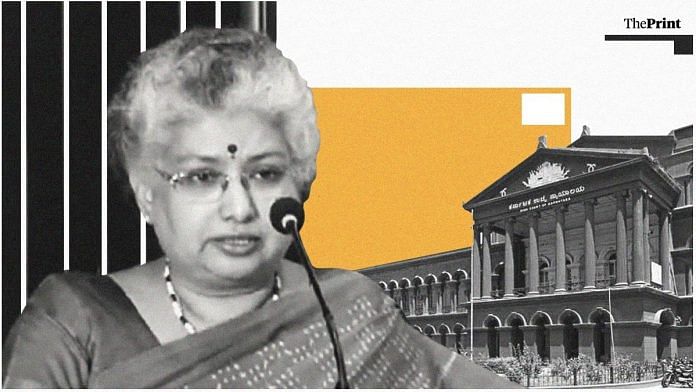New Delhi: The Supreme Court collegium is planning to recommend two names for elevation to fill existing vacancies in the apex court. But, more importantly, the collegium also has the chance to break a glass ceiling if it recommends the name of senior judge B.V. Nagarathna from the Karnataka High Court — if elevated now, she will be in line to become the first woman Chief Justice of India.
However, sources in the Supreme Court told ThePrint that while Justice Nagarathna’s name has figured in preliminary discussions between CJI S.A. Bobde and other members of the collegium, there has been “some opposition” to her candidature.
If elevated, Justice Nagarathna — who was appointed judge of the Karnataka High Court on 2 February 2008 — could succeed Justice Surya Kant as CJI in February 2027, and occupy the post until 29 October 2027.
Justice Nagarathna’s father, Justice E.S. Venkataramiah, had been a CJI for a few months in 1989.
“Her name has been discussed, but her chances are not very bright due to several reasons,” a Supreme Court source said. “Karnataka already has adequate representation in the Supreme Court, and other courts also need to be given representation. But, she is a good judge and a final decision will be taken by the collegium.”
The Supreme Court currently has two vacancies, while two more are scheduled to arise in the next few months following the retirement of Justice R. Banumathi (19 July) and Justice Arun Mishra (2 September).
The source said: “There is even the possibility that if Justice Nagarathna’s name is not cleared now, it may be cleared when two more vacancies arise later this year.”
The Supreme Court currently has three woman judges — Justices Banumathi, Indu Malhotra and Indira Banerjee.
Also read: Sexism in Indian judiciary runs so deep it’s unlikely we will get our first woman CJI
Factors against Justice Nagarathna
The main factor working against Justice Nagarathna’s prospects of getting elevated to the Supreme Court in the immediate future is that the Karnataka High Court, with a sanctioned strength of 62 judge, already has three nominees in the Supreme Court — Justices M.M. Shantanagoudar, S. Abdul Nazeer and A.S. Bopanna. None of them is slated to retire before January 2023.
Justice Nagarathna is to retire on 29 October 2024, unless she gets elevated to the Supreme Court — all SC judges get a three-year extension.
Justice Nagarathna stands at serial number 46 in all-India seniority of high court judges. Among the judges originally from the Karnataka HC, there are two judges senior to her — Himachal Pradesh High Court Chief Justice L.N. Swamy and Justice Ravi Vijaykumar Malimath of the Uttarakhand High Court.
A former chief justice of India, who did not wish to be named, told ThePrint: “When it comes to elevation to the Supreme Court, seniority and regional representation are major criteria. But then, there have been instances in the past when seniority has been overlooked while elevating somebody to the Supreme Court.”
The former CJI continued: “There are no written rules and the final choice depends on consensus within the collegium. If the collegium members decide that it is time to recommend a woman judge so that she can become the first woman CJI, she will be the most suitable.”
In terms of all-India seniority, there are only two judges who are slated to retire after Justice Nagarathna — Meghalaya High Court Chief Justice Biswanath Somadder, who retires on 14 December 2025 (plus three years upon elevation to the Supreme Court), and Bombay High Court Chief Justice Dipankar Datta, who retires on 8 February 2027 (2030, if elevated).
“So, even if she is elevated to the Supreme Court later, but before those who retire after her, she will still have a shot at the top post in Indian judiciary. But, it all depends on the collegium’s view,” said a Supreme Court source.
Also read: Supreme Court collegium’s 2 recent decisions have left the door wide open for tough questions
Other names under consideration
Supreme Court sources said other names in the “zone of consideration” are Punjab and Haryana High Court Chief Justice Ravi Shanker Jha (whose parent HC is Madhya Pradesh), Allahabad HC CJ Govind Mathur (Rajasthan), Calcutta HC CJ T.B. Radhakrishnan (Kerala), Madras HC CJ A.P. Sahi (Allahabad), Gujarat HC CJ Vikram Nath (Allahabad), Tripura HC CJ Akil A. Kureshi (Gujarat HC), Delhi HC CJ D.N. Patel (Gujarat) and J&K HC CJ Gita Mittal (Delhi).
Of these names, Justice Jha’s elevation is nearly certain, because the MP High Court will have no representation once Justice Arun Mishra retires on 2 September.
The name of Patna HC CJ Sanjay Karol, whose parent HC is Himachal Pradesh, is also being discussed, because that state no longer has representation after the retirement of Justice Deepak Gupta. Justice Karol is also senior to Justice Nagarathna in all-India seniority.
At present, there are four Supreme Court judges, including CJI Bobde, whose parent high court is the Bombay HC, while Delhi and Allahabad (the country’s largest high court) have three judges each in the SC, and Madras and Calcutta have two each.
The Gujarat HC has just one representative, which brightens the chances of Delhi High Court Chief Justice Patel.
Andhra Pradesh and Telangana have one representative each in the Supreme Court, while the Orissa, Jharkhand and Chhattisgarh HCs have no representatives.
Also read: Collegium recommendations should not be vetoed by the govt: Justice Deepak Gupta




Looks like everything other than merit is a consideration for elevation to the apex court. How to quantify merit? Well, the simplest way is to track the number of appeals filed against the judge’s verdict and the number of such appeals that are allowed.
Jus. Patel is junior to Jus. Kureshi. The author should have been cautious with his selection of words and could have used that chances of elevation of any judge from Gujarat High Court are bright.